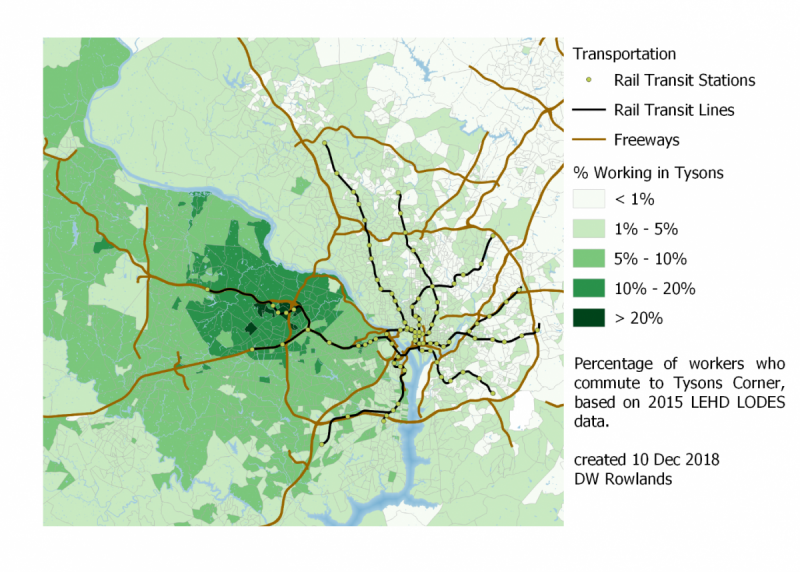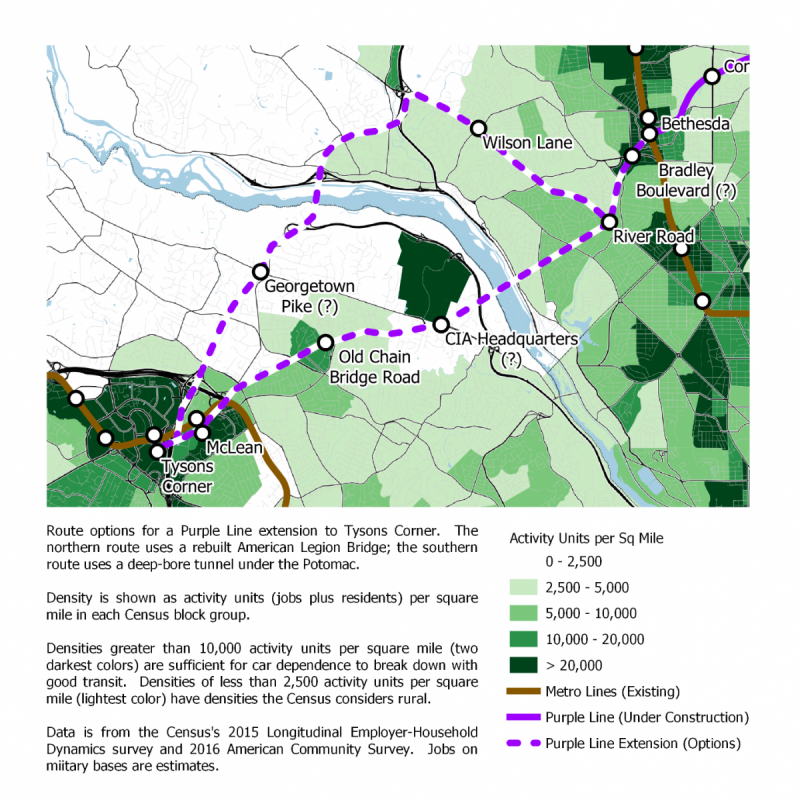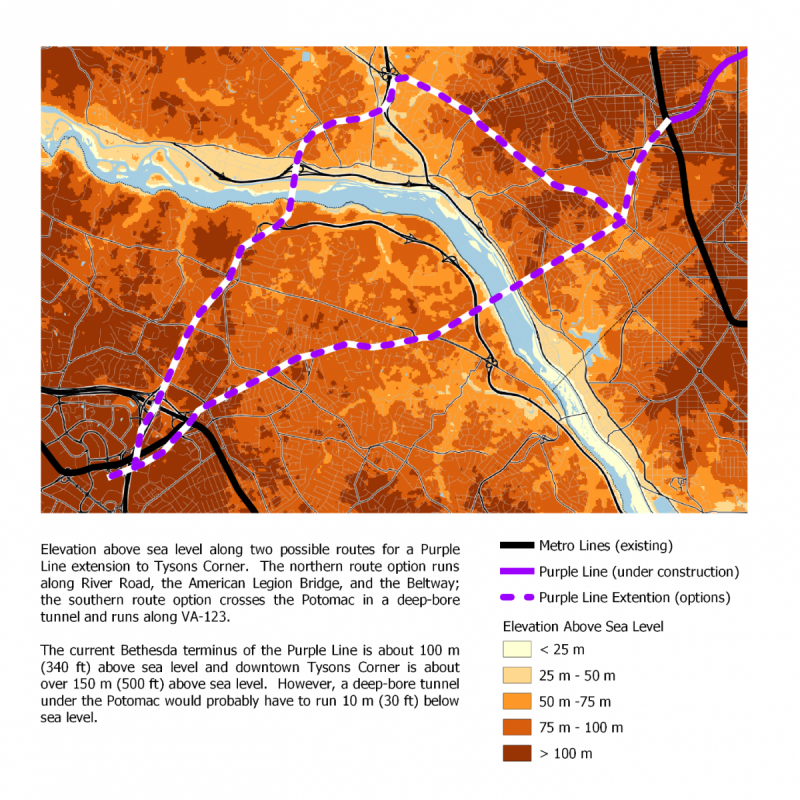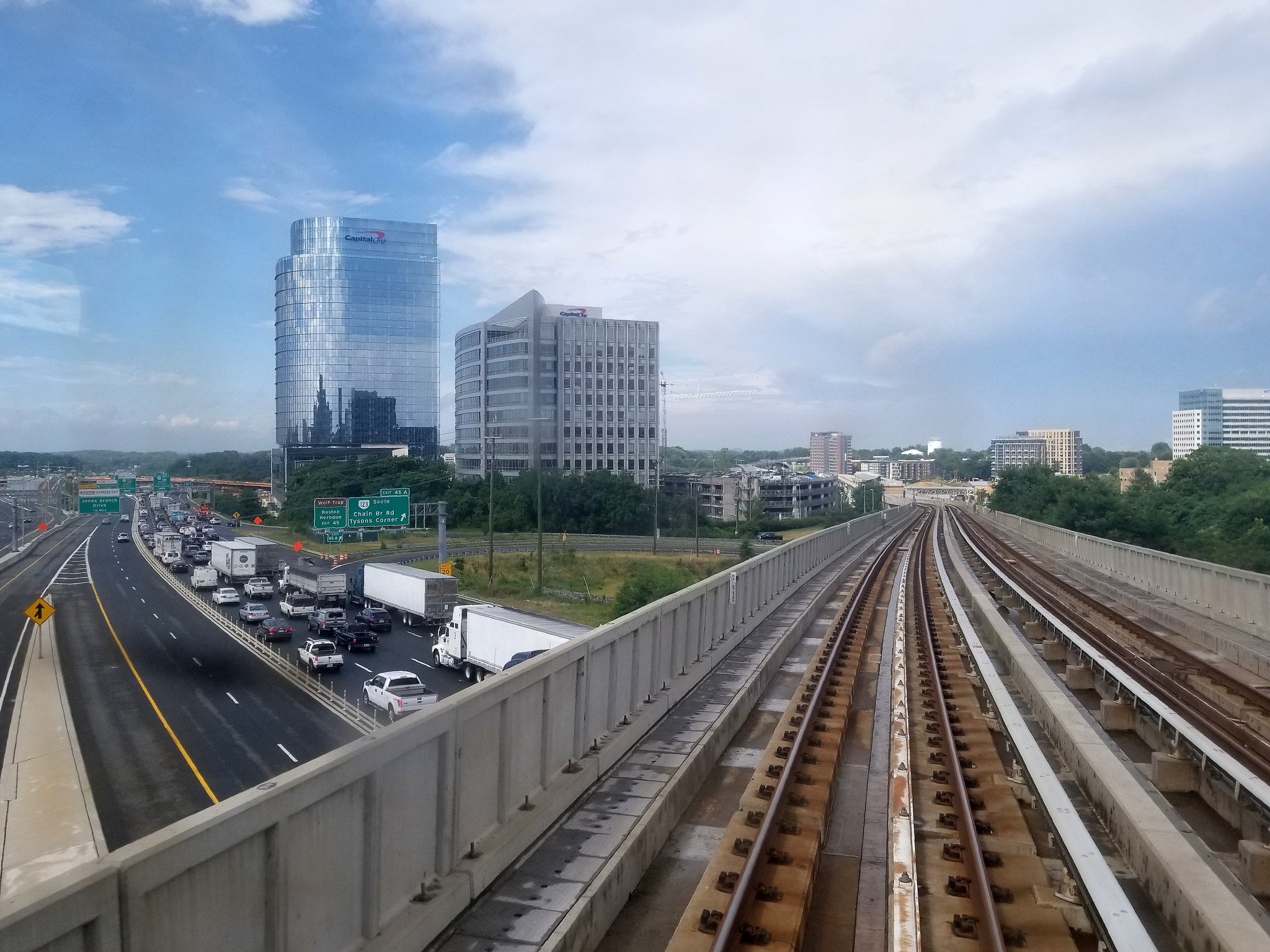This article is part three in a series focusing on circumferential transit in the Washington, D.C. region. This one deals with the possibility of extending Maryland’s Purple Line across the Potomac River to Tysons Corner. Read part one and part two.
Although the Purple Line between Bethesda and New Carrollton isn’t expected to open until late 2022, transit advocates frequently talk about the possibility of extending it. The Purple Line is the area’s first major circumferential transit project, and it is expected to have high ridership. It also connects to a series of densely-spaced job centers and residential areas, and extensions would benefit from through-running to these areas.
The most common proposed extension for the Purple Line is from Bethesda to Tysons Corner. Intuitively, this is the most obvious target for an extension: Tysons has the largest concentration of jobs in the region outside of downtown D.C. by a factor of two, making it a major commuting destination. While the Silver Line connects it to downtown D.C. and to Reston, a circumferential connection would make it more transit-accessible to suburban commuters.
The large number of jobs in Tysons Corner is a major contributor to the east-west jobs imbalance that plays a significant role in the region’s congestion. In areas as far east as Greenbelt, a meaningful percentage of workers commute to jobs in Tysons. However, the heavy congestion on the American Legion Bridge and the difficulty of getting to Tysons by transit from Maryland means that far fewer workers in Tysons live in Maryland than Northern Virginia, even though the Maryland border is only three miles away.

A map showing the fraction of workers in each Census block group who worked in Tysons Corner in 2015. Image by the author.
A good transit connection between Tysons and Maryland would help reduce travel times, and unlike proposals to add more lanes to the American Legion Bridge or to build an Outer Beltway crossing upriver, it would do so without dumping more cars onto the region’s highways.
The Bethesda Purple Line station could be a transfer point for Red Line passengers coming in from Montgomery County’s densely built-up I-270 corridor, with other transfer points everywhere the Purple Line intersects Metro.
Difficulties for a Bethesda-Tysons Corner transit line
Unsurprisingly, though, the significant benefits to a Bethesda-Tysons Corner rail link come with significant costs. Among the multiple difficulties, one bureaucratic and one geographic hurdle stand out.
The bureaucratic hurdle is that the Purple Line is not a WMATA project. It’s the Maryland Transit Administration’s (MTA) project, and it’s being built under a 30-year build-and-operate public private partnership (P3). Extending an MTA project into Virginia would require significant coordination between state and local agencies, plus the private company operating the line would presumably require significant financial support from Virginia tax payers.
How would Maryland and Virginia split the costs to build and operate the line? And would that arrangement apply only to the new portion, or to the entire Purple Line?

A map showing two possible routes for a Purple Line extension to Tysons, along with potential station locations. The background color indicates the density of activity units (residents and jobs) in each Census block group. Image by the author.
The geographic hurdle is perhaps more formidable. Bethesda and Tysons Corner are nearly 10 miles apart and are separated by a large stretch of low-density land, much of it filled with expensive single-family homes. It also contains the gorge of the Potomac River, which the National Park Service controls. Unlike the currently-under-construction Purple Line, the cost of a segment connecting these two sites will have to be justified almost entirely by ridership between its two termini.
It’s very unlikely that the National Park Service would allow a new bridge across the Potomac (not to mention the parallel Clara Barton and George Washington Memorial Parkways, both also NPS land). That means the Purple Line would either need to cross the Potomac in a deep-bored tunnel, or go on or adjacent to the American Legion Bridge. Either of these options would add significant costs to the project.
The costs of a deep-bored tunnel
The shortest plausible route for the Purple Line to Tysons from Bethesda is probably to continue along the Montgomery County-owned Capital Crescent Trail/former CSX Georgetown Branch right-of-way from Bethesda to River Road, which it crosses near Westbard. Then it would go into a deep-bore tunnel, resurface near the intersection of Dolley Madison Boulevard (VA-123) and VA-193, and continue in the median of VA-123 to Tysons Corner.
This route would be about 8.5 miles long, and more than three miles of it would need to be in deep-bored tunnel under the Potomac. This route is shown as the bottom line on this map:

A map of two possible routes for a Purple Line extension to Tysons Corner, showing elevation. Image by the author.
Based on the depth of the river and bedrock, a subway tunnel under the Potomac would need to be about 350 feet deep.
Assuming the tracks slope with a grade of 4%—the maximum sustained grade recommended for most light rail lines—a depth of 350 feet implies a 1.75-mile tunnel on each side of the river, for a total tunnel length of 3.5 miles. The western portal would be just west of the intersection of Dolley Madison Boulevard and VA-193, and the eastern portal just west of the Westbard development on River Road.
Unfortunately, a tunnel this long would add significantly to the costs of the project—probably on the order of several billion dollars for the underground section of the route.
If the deep-bore tunnel option is selected, the majority of the route would still be built above ground. On the Virginia side of the tunnel, the line would run for 3.5 miles along Dolley Madison Boulevard. For most of this section, Dolley Madison Boulevard is five lanes wide, with two travel lanes in each direction and the center lane consisting of a median broken by left turn lanes.
It’s not clear that there is enough space to add median-running light rail without removing one of the four travel lanes, and convincing VDOT to remove a travel lane from a major arterial that it currently rates as having a Level of Service of D could be very difficult. On the other hand, running in mixed traffic for half the route would certainly significantly increase travel times between Bethesda and Tysons Corner, so it is probably wise to push for a dedicated right-of-way for this portion of the line, even if it requires significant takings.
An upside to this route is that it would allow service to the small commercial district in McLean at the intersection of Dolley Madison Boulevard and Old Chain Bridge Road. This district is fairly small, with between 3,000 and 4,000 jobs and a bit more than 1,000 residents within walking distance of a potential station. However, it has the largest concentration of jobs and residents between Tysons and the Potomac, with the exception of the CIA headquarters.
While this route would also pass just south of CIA headquarters, it is not clear that a station could be built close enough to be useful for commuters, given the CIA’s significant security concerns and the large size of the site. Such a station would have to be built in the tunnel, significantly increasing costs compared to a surface station, and tunneling in the vicinity of CIA headquarters would likely pose its own legal and logistical difficulties.
A detour to use the American Legion bridge
If the costs of a 3.5 mile tunnel and the difficulties of tunneling near CIA Headquarters are considered too great, the alternative would be a detour to the American Legion Bridge to cross the Potomac above ground.
A bridge-based option would instead need to run north in the median of River Road from Westbard to the Beltway, cross the Potomac on or parallel to the Beltway, and then follow the Beltway to Tysons Corner. This route would be just over 11 miles long, but would avoid the need for deep-bore tunneling.
Theoretically, the line could be shortened by nearly a mile if it used Bradley Boulevard and Goldsboro Road to reach River Road from the Bethesda station, rather than following the Capital Crescent/Georgetown Branch right-of-way.
However, while this section of Bradley Boulevard has three lanes in each direction and could easily support median-running rail, both Goldsboro Road and the northern section of Bradley Boulevard past its intersection with Goldsboro Road have only a single lane in each direction. This shortcut would also eliminate the station at Westbard, an area that Montgomery County is looking to redevelop, and that is the only major cluster of density between Bethesda and the Potomac River.
A route using the Wilson Bridge would replace the difficulty of building in the Dolley Madison Boulevard median with a 3.5-mile segment in the median of River Road, which has a somewhat wider right-of-way. It would also eliminate the two potential stops at Old Chain Bridge Road and CIA Headquarters.
By adding 2.5 miles to the route, and given the Purple Line’s estimate average speed of about 15 miles per hour, the detour would likely add about 10 minutes to the half-hour trip between Bethesda and Tysons Corner.
Costs and benefits
In 2016, construction costs for the Purple Line were estimated at $2.4 billion. The above-ground portion of the tunnel route would be about five miles long, roughly a third of the length of the now-under-construction Purple Line. It also would not require tunneling—the under-construction Purple Line has a tunnel in the vicinity of Long Branch—and would hopefully involve minimal right-of-way acquisition, so a cost of $800 million for construction of the above-ground portion of the line might not be unreasonable.
However, the cost of the above-ground portion of the tunnel route would have to be added to the several-billion-dollar cost of the tunnel portion of the route. Although longer, and involving construction of a major bridge, the American Legion Bridge detour route would not require tunneling, and might come out at $1.5 billion for the whole line.
In the long-term, despite the bureaucratic difficulties and high cost, a tunnel route for a Purple Line extension to Tysons may be the best option, especially if the current efforts to redevelop Tysons as a walkable, transit-oriented city pay off.
Although the costs of a Purple Line extension to Tysons Corner would be quite high, the benefits might well be larger.
Tysons is one of the region’s largest commuting destinations, with about 90,000 jobs within a ~one-mile radius. As the Silver Line extends further west to Reston, Dulles, and Loudoun County, a Tysons-Bethesda rail link would connect these areas, each with large numbers of residents and increasing numbers of transit-accessible jobs, to the dense employment and residential clusters along the Purple Line and Red Line in Maryland.
In the next installation in this series, I’ll discuss other suburb-to-suburb transit options for Northern Virginia.
This article is part three in a series focusing on circumferential transit in the Washington, D.C. region. Continue reading part four.
Feature image by BeyondDC licensed under Creative Commons. This article also appeared at Greater Greater Washington.
DW Rowlands is an adjunct chemistry professor and Prince George’s County native, currently living in College Park. More of their writing on transportation-related and other topics can be found on their website. They also write for Greater Greater Washington, where they are on the Elections Committee. In their spare time, they volunteer for Prince George’s Advocates for Community-Based Transit. However, the views expressed here are their own.
